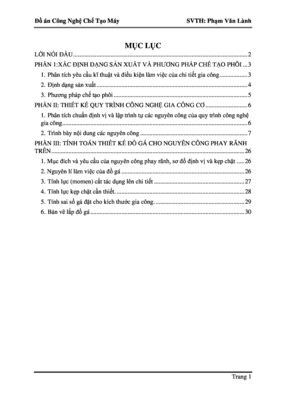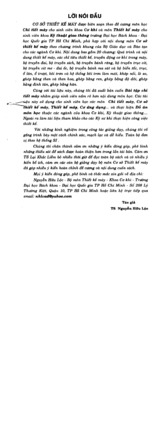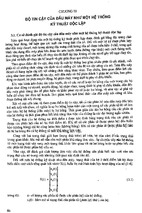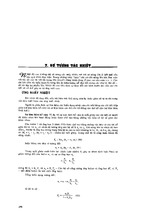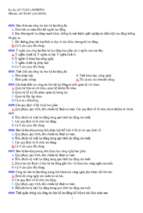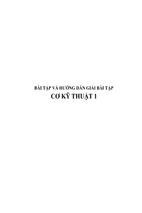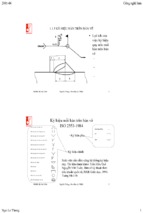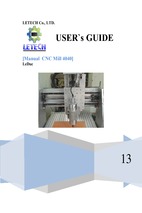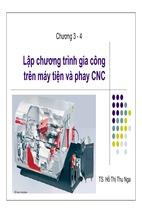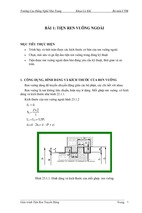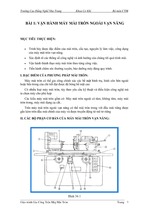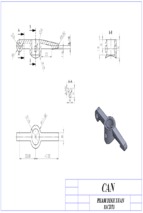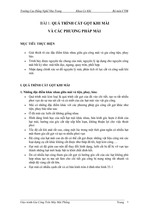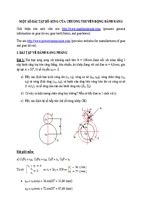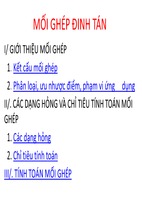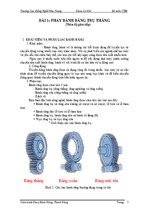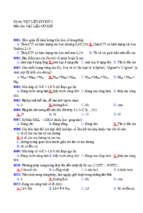Mô tả:
Generative Assembly Structural Analysis
CATIA V5 Training
Exercises
Copyright DASSAULT SYSTEMES
Generative
Assembly Structural
Analysis
Copyright DASSAULT SYSTEMES
Version 5 Release 19
September 2008
EDU_CAT_EN_GAS_FX_V5R19
Student Notes:
Generative Assembly Structural Analysis
Student Notes:
Table of Contents
Pressure Fitting connection Property Recap Exercise
Do it
Face Face Connections Property Recap Exercise
Do it Yourself
Distant Connections Recap Exercise
Do it Yourself
Analysis Assembly Recap Exercise
Analysis Assembly of Airplane Recap Exercise
Master Exercise
Copyright DASSAULT SYSTEMES
Assembly Analysis Presentation
Static Analysis on an Assembly (1): Pre-Processing
Static Analysis on an Assembly (2): Computation
Static Analysis on an Assembly (3): Results Visualization
Static Analysis on an Assembly (4): Publishing Report
Copyright DASSAULT SYSTEMES
3
4
5
6
8
9
12
13
25
26
29
31
33
35
Generative Assembly Structural Analysis
Exercise
P2
Exercises marked with this
callout will work in P2
configuration only
‘Pressure Fitting’ Connections between Rod and Axis
20 min
In this exercise you will perform an analysis of Pressure Fitting Joint. You will use an existing
Assembly Constraint to create the Connection Property.
You will:
Copyright DASSAULT SYSTEMES
Define a Pressure Fitting Connection property
Define a Clamp Restraint
Compute the Analysis and visualize the Von Mises Stress
Locally optimize the common mesh elements of the two parts
Compare the Results
Copyright DASSAULT SYSTEMES
Student Notes:
Generative Assembly Structural Analysis
Do It Yourself…
Part used: CATGAS_Pressure_Fitting.CATProduct
Define a new Static Analysis
Define a Pressure fitting connection between
the rod and the shaft
Select surface Contact Constraint as
support from the Tree
Enter overlap = 1e-5 mm
Clamp the inner surface of the Rod ‘s hole
Compute and visualize Von Mises stress
Copyright DASSAULT SYSTEMES
Apply Local Refinement
Apply Local Mesh Refinement with mesh
size = 2 mm to both surfaces in contact
as shown.
Re-compute, visualize the Von Mises Stress,
compare the accuracy. Manage the amplitude
modulation for a better visualisation
Copyright DASSAULT SYSTEMES
Student Notes:
Generative Assembly Structural Analysis
Exercise
P2
‘Face Face’ Connection Properties Recap Exercise
30 min
In this exercise you will apply different Face Face Connection Properties to the foot peg
assembly’s part constraints.
You will use:
Slider Connections
Fastened connections
Contact connections with springs
Copyright DASSAULT SYSTEMES
Then you will perform a static analysis on the foot peg assembly
Copyright DASSAULT SYSTEMES
Student Notes:
Generative Assembly Structural Analysis
Student Notes:
Do It Yourself (1/2)
Part used: CATGAS_FootPeg_Recap.CATProduct
Create Static Analysis Case
Apply slider connection to the pin and the
foot peg cylinder
Pin
Small face
Peg
Peg mount
Apply contact connection between the peg
Raised Pad and small face of Page Mount
Copyright DASSAULT SYSTEMES
Raised
pad
Apply fastened connections between the Pin base
surface and Peg surface touching to Pin base.
Copyright DASSAULT SYSTEMES
Foot peg
cylinder
Generative Assembly Structural Analysis
Do It Yourself (2/2)
Apply the Restraints
Apply a clamp on the back surface of the peg mount
Apply a surface slider on the cylindrical surface of
the foot peg
Apply the Loads
Apply a distributed load of 3000N along the z axis
(facing downwards) to the top surface of the peg.
Change Element Type
Use parabolic elements (for both parts of the
assembly). Check the consistency of the model
Copyright DASSAULT SYSTEMES
Compute Analysis
Observe Von Mises Stress, adjust the colour palette
in order to visualize the areas where the assembly is
most likely to fail
Copyright DASSAULT SYSTEMES
Student Notes:
Generative Assembly Structural Analysis
Exercise
Student Notes:
P2
Distant Connection Property Recap Exercise
60 min
In this exercise you will compute a Tightness Analysis in the case of an under-pressure tank.
You will:
Copyright DASSAULT SYSTEMES
Define Virtual Bolt Tightening Connections and apply a pressure inside the tank
Perform a Static Analysis
Re-compute Analysis with Adaptivity
Copyright DASSAULT SYSTEMES
Generative Assembly Structural Analysis
Do It Yourself (1/3)
Part used: CATGAS_Tank_Assembly_Recap.CATProduct
Enter the Generative Structural Analysis workbench
Define a Contact Connection Property between the tank
and the cover
Copyright DASSAULT SYSTEMES
Define a Virtual Bolt Tightening Connection Property on each
corner, using the coincidence constraints previously defined
Define a Tightening Force = 5000N on each bolt
Copyright DASSAULT SYSTEMES
Student Notes:
Generative Assembly Structural Analysis
Do It Yourself (2/3)
Apply a pressure
Apply a pressure = 500Pa on all the internal surfaces
Copyright DASSAULT SYSTEMES
Fix the tank
Clamp the bottom of the tank
Copyright DASSAULT SYSTEMES
Student Notes:
Generative Assembly Structural Analysis
Student Notes:
Do It Yourself (3/3)
Compute the analysis, visualize the displacements
Create Precision image and the fourth maximum Local
Error extrema
Use Global and Local Adaptivity to reduce Local Error
Enter Objective Error = 10% for Global Adaptivity
and Objective Error = 5% for Local Adaptivity
Copyright DASSAULT SYSTEMES
Re-compute with Adaptivity and conclude about the
Result’s Accuracy for 3 iterations. Use More iterations
in case Objective error is not achieved. However it will
take more computation time.
Copyright DASSAULT SYSTEMES
To complete this
step you will require
EST Product
Generative Assembly Structural Analysis
Analysis Assembly Recap Exercise
This exercise will help you to grasp the concepts of Analysis Assembly
Management.
Copyright DASSAULT SYSTEMES
Analysis Assembly of Airplane Recap Exercise
Copyright DASSAULT SYSTEMES
Student Notes:
Generative Assembly Structural Analysis
Analysis Assembly
Student Notes:
Recap Exercise
P2
60 min
Copyright DASSAULT SYSTEMES
This exercise is composed of four main steps:
Attach shape to each part in assembly
Create Analysis Connections between components
Assign Analysis Connection Property to each Analysis Connection
Apply loads and restraints
Compute global analysis and view results
Copyright DASSAULT SYSTEMES
Generative Assembly Structural Analysis
Student Notes:
Analysis Assembly – Design Intent
You will perform analysis assembly of airplane components which includes
Fuselage-A, Fuselage-B, wing and Fuselage-C. You will reuse existing part analysis
documents for of these components for global analysis.
You will be provided with
Product document which
contains assembly of
Fuselage-A, Fuselage-B,
wing and Fuselage-C.
Copyright DASSAULT SYSTEMES
You will attach
corresponding Analysis
document to each
component in product
document
After attaching documents you will apply analysis connections and connection properties to
connect two mesh parts to transfer DOFs. These connection and connection properties will be
applied between Fuselage-A and Fuselage-B, Fuselage-B and wing, fuselage-B and Fuselage-C.
Finally, you will apply load and restraints and perform global analysis.
Copyright DASSAULT SYSTEMES
Generative Assembly Structural Analysis
Student Notes:
Analysis Assembly – Design Process
1
Attach Shape to each
component in assembly
2
Create analysis connection and
assign connection properties
3
Copyright DASSAULT SYSTEMES
Apply loads
and restraints
4
Compute Global Analysis
and view Results
Copyright DASSAULT SYSTEMES
Generative Assembly Structural Analysis
Do It Yourself (1/9)
Load ‘Fuselage-A.CATAnalysis’, ‘Fuselage-B.CATAnalysis’,
‘wing.CATAnalysis’ and ‘Fuselage-C.CATAnalysis’
Saving Files in separate folders
save each using CATIA ‘File > Save Management’ on your machine in
separate folders for future use. Use ‘Propagate directory’ option to save files
linked with analysis files.
Close each CATAnalysis file after saving
Load AAM.CATProduct and attach shape to Fuselage-A (Fuselage-A.1) part
Select saved file Fuselage-A.CATAnalysis
Copyright DASSAULT SYSTEMES
Attach shape to Fuselage-B (Fuselage-B.1) part
Select saved file Fuselage-B.CATAnalysis
Copyright DASSAULT SYSTEMES
Student Notes:
Generative Assembly Structural Analysis
Do It Yourself (2/9)
Attach shape to Wing (Wing.1) part
Select saved file Wing.CATAnalysis
Copyright DASSAULT SYSTEMES
Attach shape to Fuselage-C (Fuselage-C.1) part
Select saved file Fuselage-C.CATAnalysis
Switch to ‘Analysis & Simulation’ workbench
Select Static Analysis and click OK
Save the file as AAM.CATAnalysis
Copyright DASSAULT SYSTEMES
Student Notes:
Generative Assembly Structural Analysis
Student Notes:
Do It Yourself (3/9)
Apply Points to Points Analysis Connection between Fuselage-B and Wing
Click on Apply Points to Points Analysis Connection icon
Select six vertices on wing in First component as shown
Vertices shown
in boxes
Copyright DASSAULT SYSTEMES
Select corresponding four mesh parts for Wing from tree in ‘Mesh Parts’ as shown
Copyright DASSAULT SYSTEMES
Generative Assembly Structural Analysis
Do It Yourself (4/9)
Select six points on Fuselage-B in Second component as shown
Copyright DASSAULT SYSTEMES
Select corresponding ‘Lower_Fuselage’ mesh part for Fuselage-B in ‘Mesh Parts’ as shown
Click ‘OK’ to confirm
Copyright DASSAULT SYSTEMES
Student Notes:
Generative Assembly Structural Analysis
Do It Yourself (5/9)
Apply Nodes to Nodes Connection Property
Click on ‘Nodes to Nodes Connection Property’ icon
Select ‘Points to Points analysis connection’ as support
Select ‘Type’ as ‘Rigid’
Connection Status in Model checker must be ‘OK’
Copyright DASSAULT SYSTEMES
Apply General analysis connection between Fuselage-A and Fuselage-B
Select ‘Fuselage_A_Connect’ group from Fuselage-A as First component
Select ‘Fuselage_B_Connect_front’ group from Fuselage-B as Second component
Name this connection as ‘GAC_Fuselage_A_B’
Copyright DASSAULT SYSTEMES
Student Notes:
- Xem thêm -


